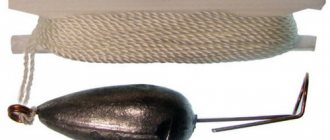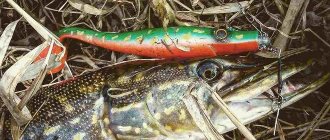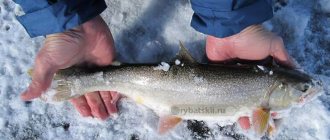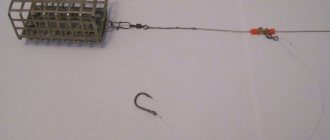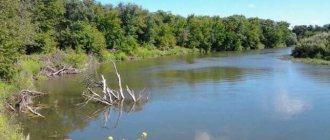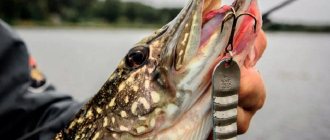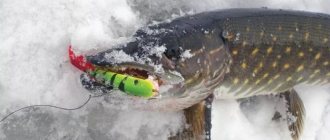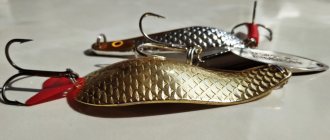The cherished trophy of every fisherman is a pike. But if many people know how to catch it in the summer, then there are few specialists in winter catching “toothy”. Fishing for pike from ice in winter is not the easiest thing to do. A catch awaits only those who have understood all the nuances, properly prepared the gear and identified a potentially catchy place. Choosing the time and taking into account weather conditions is also important.
Let's discuss all the components necessary for successful pike fishing in winter using a spoon. Everyone will find useful information for themselves - both beginners and experienced fishermen.
Specifics of pike trolling in winter
How does this fish behave when frost sets in? Why do its habits change on a body of water after it becomes covered with ice? Knowing the answers to these questions, it will be easier for you to understand where and how to catch pike with a spoon in winter.
- Firstly, this fish ceases to be as active as in the summer. If in open water it happily wanders throughout the entire water area in search of food, then on winter days it stays in the same places, cruises and feeds within a specific point. The predator practically does not make long swims. Attacks with quick and short bursts. The angler’s task is to understand where the pike is in order to place the bait as close to it as possible. Therefore, if there are no bites, do not sit in one place - move around the reservoir, drill more holes, fish for new points.
- Secondly, in winter the behavior and feeding activity of the “toothy” depends even more on weather conditions. The worse they are, the weaker the pike bite. In severe frosts, of course, she does not stop feeding, but she does this rarely and as if lazily. When it is cloudy and relatively warm (the thermometer is above -15 °C), this fish has a better appetite. Also, days that are more favorable for fishing are those on the eve of which there were no surges in atmospheric pressure that affect pike fishing in winter. Therefore, carefully study the barometer readings and the weather forecast before you go winter pike fishing with a spoon.
- Thirdly, the fish becomes very shy. Even perch and pike perch are much easier to catch in winter than pike. It happens that you drill a hole, and the toothy one, frightened, swims away from this place and does not return at all during the day. In the best case, it arrives after half an hour or an hour. Therefore, the fisherman should behave silently, do not make sudden movements, and drill holes immediately.
Behavior of pike on the first ice
After the formation of ice, small grass pike, weighing up to 2-3 kilograms, mostly concentrate in shallow coastal areas. The prospects of a place are directly proportional to the presence of shelters in the form of remnants of vegetation, unevenness in the structure of the bottom, snags, and other obstacles, among which a pike can ambush. Its potential victims also choose the same areas, trying to hide in a life-saving support in the event of a predator attack.
There is no point in looking for pike on a clean, flat bottom. There is nowhere to hide in such areas, so neither the predator nor the potential victims feel comfortable here.
Moving on to specifics, we note that the most promising areas for pike fishing at the beginning of the winter period will correspond to depths from 1.0 to 2-2.5 meters.
Often the predator goes to shallower depths in search of fry. This behavior of pike in winter is observed two weeks after the formation of ice, and until the deficiency of oxygen dissolved in the water forces the small fish to go to greater depths. Accordingly, when fishing during the period under review, a completely competent solution would be to install several girders in close proximity to the remains of aquatic vegetation almost under the shore.
A similar picture is observed at the end of the winter fishing period, when at the mouths of tributaries flowing into the main body of water, the level of oxygen dissolved in the water sharply improves, which makes these shallow waters promising for fishing.
Read! Fishing for pike in October using a spinning rod
Touching upon the topic of the last ice, one cannot fail to mention the peculiarity that in extensive reed thickets the general oxygen situation may be better than in the whole reservoir. And this despite the fact that there is plenty of rotting vegetation in these thickets. This phenomenon is explained by the fact that air inevitably gets under the ice through the hollow reed stems. So you can catch pike in such places.
Tackle components
The spinning rod you used to catch pike in summer and autumn is not suitable for winter fishing. You will need specially mounted gear.
Rod
Some fishermen use homemade fishing rods. But making them is not easy, and store-bought options are much better. Therefore, we advise you to purchase special “sticks”.
For example, carbon rods with cork handles have proven themselves well. There are also good fiberglass models. But carbon is preferable. Preferably with a titanium whip and guide rings with an SIC insert (allow you to fish with braided lines).
In terms of length, the optimal spinner is 35–40 cm. It is important that the rod is durable, not heavy and fits comfortably in the fisherman’s hand. Also choose “sticks” for vertical trolling. In another way, they are also called vertical fishing rods.
Coil
For the role of a reel for pike tackle, a medium-sized model with a diameter of about 10 cm is suitable. Capacity is up to 50 meters of fishing line. The ideal option is medium or even budget in the price segment. Be sure to be inertial with a high-quality reverse stopper and lever. Such characteristics of the reel will help when landing fish.
fishing line
An important element of any gear. When assembling a fishing rod for trolling pike, you should choose the “cord” responsibly and carefully. Basic requirements for it:
- Diameter. After all, we are going to fish with a spoon. These are heavy baits. And the pike itself resists solidly. In addition, there is always a chance that a specimen weighing 5–7 kg will bite. Therefore, the cross-section of the winter fishing line should be about 0.3 mm. Not less.
- Strength. This parameter is also important. When purchasing, check the tensile strength. The fishing line for pike tackle must be at least 7 kg.
- Rigidity. In this regard, braided line is better suited, but it often freezes, which prevents the bait from being cast correctly. Therefore, fishermen generally give preference to high-quality monofilament fishing line - elastic and with minimal stretch parameters.
We briefly described what fishing line should be like for winter trolling for pike from ice. On fishing forums you can find out a little more - read reviews on specific manufacturers and models.
We recommend reading
Catching pike with rattlins in winter and catchy lures Fishing for pike with rattlins in winter is interesting for both beginners and experienced anglers. This solid body bladeless bait with…
Tackle for winter pike fishing
For winter fishing for pike you need the most reliable and strong gear. They must withstand strong resistance from large fish. An ordinary fishing rod with a nod, which is used for fishing perch or dace, is not suitable. When played, it will simply break. The fishing rod must meet the following characteristics:
- a long rod, as they fish while standing; - guard 10 centimeters (optional); — comfortable handle; — fishing rod rigidity; - convenient reel, can be reeled; - thick and long fishing line (from 0.25 to 0.4 millimeters); - durable and sharp hooks (single, double and tees); - a mandatory metal (tungsten or lead) leash.
Winter fishing rod equipment
All the components are ready, it’s worth thinking about equipping the fishing rod. It includes a nod and a leash. What are they for and is it possible to do without these elements? Let's figure it out.
Nod
This element is not used by everyone. Pike are often cast vertically. With this method, the nod does not help the angler improve his game, since pike lures are large and heavy. Allows you to see the bite? What for? If the fish grabs the bait, you will feel it perfectly with your hand. Therefore, whether to give a nod or not is your choice. An alternative is a simple tulip.
Leash
Be sure to install it if, as they say, you don’t want to be left with your nose. The pike has sharp and strong teeth, which can bite through ordinary fishing line with one movement. She also has a habit of grabbing her prey by the head. If your spinner is tied to a regular fishing line, then there is a high risk of losing both the catch and the bait.
What to use as leashes? There are several options:
- Leash made of string or steel (low price, but average characteristics in terms of visibility, flexibility and strength).
- Fluorocarbon with a diameter of 0.25-0.3 mm (best if your target is a medium-sized pike weighing about 1 kg).
- Kevlar (a modern material that is durable, soft and small in diameter).
- Titanium (we recommend using it with expensive baits, as it is very durable, but there is a drawback - it is often noticeable to fish).
Don't forget about the spinners! This is the most important element of the gear. The effectiveness of fishing largely depends on the arsenal of lures for pike in winter. We’ll talk about choosing spinners for pike fishing in winter in a similar way another time - we’ll dwell on how to choose them, which ones are best suited in color and shape, which options from which manufacturers are recommended by experienced sports fishermen, and much more. etc.
But from personal experience, we note that pike are more actively caught with spinners from ACME Kastmaster, Williams Wabler and Rapala.
The optimal leash length for trolling pike in winter is 20–30 cm.
Features of winter fishing
Selecting tackle and bait is only half the battle; it is important to correctly present the bait and balancer to the predator. With a simple lowering and raising, the pike is unlikely to pay attention to the bait. To attract attention you need to:
- periodically lower the spoon completely to the bottom, and after a short pause, jerkily lift it into the water column;
- let the spoon or balancer hang in the water for a few seconds, and then actively move it again;
- create pauses between jerks of the bait; it is during this period that the pike usually attacks.
To catch a trophy specimen, you need to choose your own game for each hole.
Another feature of catching a toothy fish in winter is time; it will be caught all day long; morning and evening dawns will not have a special effect on the bite. With the onset of darkness, few people catch pike; in most cases, fishermen who come overnight leave their girders with the hope of catching a handsome burbot with this tackle.
Pike fishing in winter is carried out using different methods, each of which will be effective. The main thing is to choose the right components and assemble high-quality tackle so that even a large specimen cannot escape.
Choosing a fishing spot
You will be able to find a point where pike hunt, and your chances of going home with your catch will increase dramatically. Therefore, choose your fishing spot carefully. Typically, in most reservoirs from December to March, the predator tries to feed:
- Near the snag;
- On changes (steps) of the bottom relief;
- Near slopes, holes and sudden changes in depth;
- At the border of underwater plants with areas of open water;
- Not far from rapids, confluences of other rivers or springs.
As you probably understand, pike choose for feeding in winter those points where it is inconspicuous and there are a lot of other fish, which become its food. Such places are promising for ice fishing with a spoon.
If you know the reservoir well and you often fish here in the summer, then there will be no problem finding a pike spot. It’s another matter if you come to fish on a new lake or river. An echo sounder can help, showing areas where fish feed. Or you can ask local fishermen - no one will reveal the most catchy places, but it’s quite possible to suggest a hole or two.
In winter, pike can be caught in areas with different depths. The fish feed both in shallow water and on decent dumps and holes. Where the food supply is larger, the “toothy” one usually hides there.
At what depth does pike winter and where to look for it?
The spotted beast can be found at different depths in winter. During the first ice and at the end of the season, it often stands in shallow water and medium depths of up to 3 meters. In the dead of winter it prefers holes, dumps, ditches, reaches, and riverbed areas with a depth of 4–10 meters.
Despite its attachment to all kinds of shelters, pike can be found in winter at almost any depth.
In shallow-water locations, the predator chooses various depressions and changes in the bottom topography for its ambushes. In deep waters, on the contrary, it gravitates towards tubercles and hills, stays near the “tables” of white fish, and presses against the upper part of edges and slopes.
On large ponds and reservoirs
It is not easy to find fish in large enclosed water areas and reservoirs. It can migrate across a body of water, focusing on the movements of the food supply. In addition, the predator’s sites vary depending on the winter period and weather factors.
The first place to start searching for predators is coastal bays and backwaters with depths of up to 3 meters. It is necessary to carefully examine the area, detecting local differences in depth and separately lying snags. Most likely, the pike is in ambush here.
We recommend reading: How to catch burbot in the fall: gear, bait, fishing methods
The coastal edge must be examined, especially at the border of aquatic vegetation and reeds. Then they look for dumps, pits, ditches and ravines. At great depths, you need to look for hills, hillocks, plateaus or submerged tree trunks.
Winter stops for pike on rivers
Pike feel good in the river all winter. Oxygen-saturated water, the presence of a current, and a rich food supply allow the fish to survive difficult times. Promising places for catching it are:
- coastal edges;
- long ditches and ravines;
- channel dumps;
- snags;
- pools with reverse flow.
Rivers with uneven bottom topography are the best places for fishing for pike from the ice in the dead of winter.
In channel holes, you can count on a bite from a large or trophy specimen, especially if there is a submerged tree or boulder there.
How to find pike in winter on a small lake
It is not difficult to spot pike in a lake or pond. First, the coastal zone is examined, especially areas near capes, trees that have fallen into the water, and a coastal strip of algae. Then they look for anomalous points - local hills and depressions, flooded snags, single islands of vegetation.
In small enclosed reservoirs, a good bite of the toothy predator is observed at the beginning of winter. If there are no springs in the lake, feeding it with fresh water, then by January the activity of the fish decreases, it experiences oxygen starvation and stops feeding.
Time for ice fishing for pike using lures
Winter fishing with a lure for pike is possible during the entire period of “hard” water, that is, when lakes, rivers and ponds are covered with ice. However, at what time can it be more successful?
On the first ice, the pike does not bite as actively as in the fall, when it was really hungry. Nevertheless, the chances of catching a good specimen and not leaving with nothing are very good.
In early winter, pike still have the strength to move around the reservoir in search of food. And the oxygen content in water is high. Due to this, the predator diligently stores up nutrients. There is a high probability that your bait will not go unnoticed.
In December, winter trolling for pike is often best just after sunrise or an hour before sunset.
Closer to the dead winter and in January, the pike bite worsens. The oxygen balance in rivers and lakes becomes below normal, to which any fish reacts with less activity. Including the stern one.
In the middle of winter, it is difficult to identify time periods during the day when pike bite better. She can grab the bait in the morning, during the day, and at nightfall, when it becomes dark.
Closer to spring, this predatory fish again begins to eat more and more often. She moves more actively around the reservoir. All this increases the angler’s chances of catching it. Moreover, the best bite at the end of winter usually occurs during the daytime.
Real examples of successful and unsuccessful conditions
I will try to simulate and describe some situations with the dynamics of the most significant, in my opinion, weather conditions, when I was able to achieve positive results in winter fishing - or when it was practically “empty”.
1. In my successful practice of catching pike in winter girders, I can remember more than a dozen fishing trips, when for several days (or even a week) before departure the weather was quite frosty, without precipitation, with a cloudless sky and weak wind conditions (winds from the north, northeast and east directions). The prevailing anticyclone at that time was accompanied by high atmospheric pressure - sometimes even above 760 mm Hg. And the day before or during the departure, the weather conditions began to change dramatically.
During the passage of a warmer cyclone, atmospheric pressure dropped sharply, and the air temperature confidently tended upward, towards zero. The wind directions changed to the exact opposite, and the southern, southwestern or western became predominant. The presence of precipitation, snow or rain, significantly increased the chances of successful fishing. And with such a radical change in the weather, the toothy predator was distinguished by very high feeding activity throughout the daylight hours. And the number of pike bites at this time went off scale, and this was in suburban reservoirs, subject to enormous pressure from the numerous fishing fraternity.
2. Now I remember situations when the pike was minimally active, or its bites were completely absent. One to three days before departure, there was either a thaw, or the air temperature was slightly below zero. The atmospheric pressure was quite low, the winds were in the southwestern or western directions, and there was periodic precipitation in the form of snow, sleet or rain. On the day of departure, or even the next day after it, there was a rather sharp cold snap.
Atmospheric pressure began to rise, and the amount of precipitation decreased significantly, cloudy with clearing or clear weather set in. The winds also changed, with northern and northwestern directions becoming predominant. The air temperature rapidly dropped below zero. With such climatic changes, one or two bites could only be counted on in the early morning or in the evening twilight, otherwise the toothy fish would not show itself at all.
3. Another interesting situation that deserves to be talked about. If a cold anticyclone that arrived a week or two ago prevails, clear frosty weather with high atmospheric pressure has established, wind conditions are minimal, and air humidity has dropped to 50 - 60% (record for our area), then in such weather it is possible to see the best In this case, a one-time bite on the girders, usually in the daytime.
Snowfall brought hope for pike activity
But if the weather conditions have changed barely noticeably, the pressure has dropped by only a few millimeters of mercury, the wind conditions (the most common in such conditions in our country are southeastern or eastern winds) have slightly increased and the air humidity has gradually increased - these climatic fluctuations, barely perceptible by humans, pikes serve as a clear signal for food activation. With such dynamics of weather factors, I was more than once able to achieve excellent results, when the toothy beauty pleased me with confident bites throughout the day. To support this, I will give one striking example from my practice.
And the hope came true
Several years ago, in the second half of January, I came to the Vileika Reservoir, located a hundred kilometers from Minsk, for a couple of days. On the channel irrigation, which I chose to place the vents, the depths were 4 - 4.8 m, and the bottom topography was quite rugged. On the first day of departure, the weather conditions were as follows: pressure - 758 mm Hg, east wind - no more than 3 m/s. Sunny, no precipitation weather with an air temperature of minus 15 - 17 degrees (and at night - frost of 29 degrees). The anticyclone that formed such icy weather had dominated our region for about a week.
A snowstorm is approaching - a time of special preparedness
The Zherlitsy, as expected, took up their combat positions an hour before dawn. But throughout the whole day I only had two bites - one at 8.15, still in the dark, the other at 12.40, and the pike were small, up to a kilogram. On the second day, I also placed the girders on the riverbed irrigation. But the weather has changed a little. The pressure dropped slightly - to 755 mm Hg, the wind increased slightly - to 3 - 8 m/s, changing direction to the southeast.
The air temperature remained virtually unchanged. And still the same cloudless sky. But the pike, clearly sensing something, became much more active. Already at dawn there was a short-term exit, during which I managed to realize two bites out of three. During the day, between 12.50 and 13.30, I was lucky enough to see three more flags raised - and I caught two qualifying pike. After 15.40, with the appearance of slight clouds in the sky, the evening appearance of the spotted beauty occurred, which lasted just over an hour.
I saw four pike bites, and realized three. One of the caught pikes almost reached three kilograms. There is such a significant activation of the toothy predator with barely noticeable changes in weather conditions. It would be appropriate to note here that after this trip, a dramatic change in weather conditions occurred only three days later - the long-awaited warming arrived.
4. Now about weather situations that used to be quite rare, but in the last 2 - 3 seasons of hard water have begun to be observed more often. I call these conditions “seesaws.” There is a thaw for a day or two or the air temperature is slightly below zero. The prevailing wind is from the south or southwest. Pressure is low or its value is at the normal level for the region in winter. A small amount of precipitation is also typical for this time. And after several such days there is a sharp change in weather conditions, the pressure jumps up significantly, the wind intensifies, and its direction changes (usually the north or northwest wind blows).
The air temperature drops, especially at night, and the amount of precipitation is noticeably reduced or practically absent during this period. Such weather conditions are observed for several days, and then a cyclone comes again, bringing warming and increased cloudiness - another break in the weather occurs. And such a short-term change in climatic conditions occurs within one to two weeks.
Pike at this time is characterized by low feeding activity, only short-term exits occur, and even those are irregular - and only in the morning hours or in the evening twilight.
The weather situations I simulated are for informational purposes only; they may be different for different regions with their own climate. And you have to go fishing when you can, and not adapt to definitely better weather conditions. And any result, even negative, is still a result that is an invaluable grain of many years of fishing experience.
Technique for trolling winter pike
So, we have decided when and where it is most effective to fish. The gear is ready, the equipment is mounted. You can start fishing.
Casting a pike from the ice is not an easy task for a beginner. So let's talk about the technique:
- First of all, we drill a sufficient number of holes. For some, three to five is enough. Others need about ten. With experience you will understand how much you need. We drill holes at a distance of 5–10 meters from each other.
- Then we lower the spoon into the water. Let the bait touch the bottom. Next, we wind the fishing line on the reel a little so that the spoon rises 5–6 cm.
- The next action is to sharply raise your hand with the rod about half a meter. During this jerk, your spoon will raise turbidity from the bottom, which can attract pike. A curious fish will want to check to see if it is a small fish frolicking in the mud or a wounded roach unable to swim.
- Now we lower the spoon back to the bottom. We repeat several times.
- Then we pause, leaving the spoon motionless for some time. How long? From 5 to 10 seconds. The colder the air temperature, the longer the pause should be. After all, the pike becomes slower in such conditions, and an overly active bait will only scare it away.
- If there are no bites for 15–20 minutes, then replace this spoon with another one. Wells can be changed more often.
- When the pike grabs the bait, you won't miss it. The nod will go down sharply, and a blow will be felt through the handle of the rod. You need to fish confidently, but slowly. If necessary, you can use a hook.
Of course, the spinner game can be diversified. Micro-twitching, barely noticeable oscillations to the side, freezing of the bait, etc. are allowed. Who knows which wiring option will work today.
We recommend reading
Catching pike in winter on a girder and how to arrange the tackle correctly Winter fishing for pike on a girder successfully occurs both on the first ice and on the last one. But in a later period...
